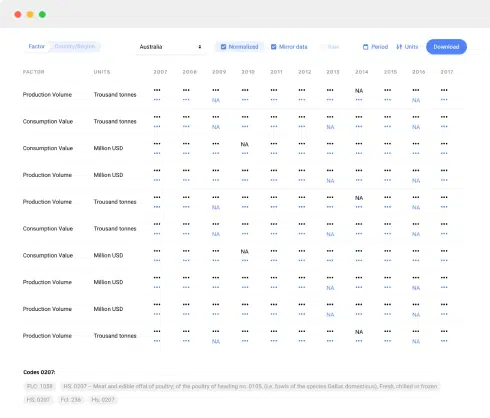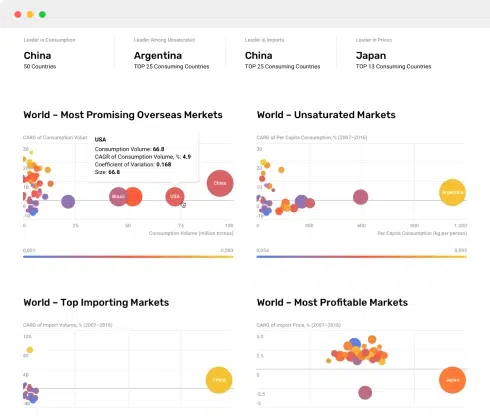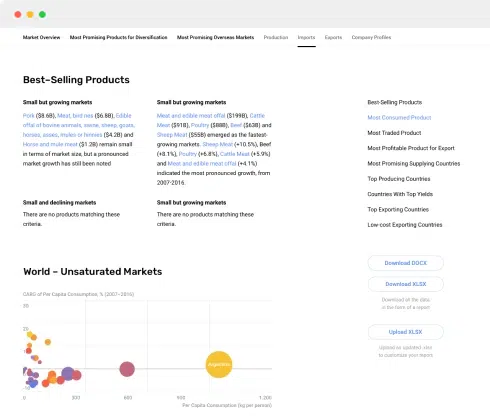
Lattafa Dominates with 22% Market Share, Premium Brands Show High Price Elasticity
Understanding brand positioning and market dynamics is critical for strategic decision-making. This analysis leverages IndexBox data to dissect brand performance across key metrics, including ratings, reviews, pricing, and sales volume, providing actionable insights for optimizing market strategies.
Methodology
The data is sourced from IndexBox monitoring tools tracking the Amazon marketplace in the United States, with delivery location ZIP code 60007. The dataset reflects product categories based on specified search keywords. For detailed brand metrics, refer to the Brands section of IndexBox.
Rating vs Reviews: Quadrant Analysis
The scatter plot segments brands into four quadrants: Star Brands (e.g., Yves Saint Laurent, Versace), Rising Brands (e.g., Lattafa, Tom Ford), Niche Brands (e.g., Gucci, Victorias Secret), and Problematic Brands (e.g., MOBETTER FRAGRANCE OILS, Al-Rehab). Star Brands should focus on maintaining quality and leveraging social proof, while Rising Brands need to address quality gaps. Niche Brands can expand reach through targeted campaigns, and Problematic Brands require product and marketing overhauls.
Price vs Sales Volume: Demand Elasticity
Low-price brands like Lattafa and Al-Rehab achieve high sales volumes, while premium brands (e.g., Tom Ford, Gucci) exhibit lower elasticity. Versace and Yves Saint Laurent strike a balance with moderate prices and high volumes. Recommendations include optimizing price points for premium brands and expanding SKUs for volume-driven players.
Price Distribution: Segmentation Insights
The histogram reveals a right-skewed distribution, with 70% of products priced below $50. Premium outliers (e.g., >$200) represent niche demand. Brands should segment assortments into budget (<$50), mid-tier ($50–$150), and premium (>$150) to cater to distinct customer segments.
Market Share: Leadership and Diversification
Lattafa leads with 22% share, followed by Versace (7.4%) and Armaf (5.6%). The "Others" category (24.5%) highlights fragmentation. Leaders should defend share through innovation, while smaller brands can target underserved niches via differentiation.
Boxplot: Price Dispersion Analysis
Yves Saint Laurent shows the widest price range ($6–$210), while MOBETTER FRAGRANCE OILS has no variability. Brands with narrow ranges (e.g., Victorias Secret) should introduce tiered pricing, while premium brands can leverage bundling to justify higher price points.
Custom Search Request
IndexBox enables on-demand parsing via the Custom Search Request panel or API (POST /api/brand/search), allowing users to save parameters and track request statuses for real-time insights.
Conclusion
Key takeaways include Lattafa's volume dominance, premium brands' pricing challenges, and opportunities for assortment segmentation. Regular monitoring via IndexBox ensures agility in responding to market shifts.
1. INTRODUCTION
Making Data-Driven Decisions to Grow Your Business
- REPORT DESCRIPTION
- RESEARCH METHODOLOGY AND THE AI PLATFORM
- DATA-DRIVEN DECISIONS FOR YOUR BUSINESS
- GLOSSARY AND SPECIFIC TERMS
2. EXECUTIVE SUMMARY
A Quick Overview of Market Performance
- KEY FINDINGS
- MARKET TRENDSThis Chapter is Available Only for the Professional EditionPRO
3. MARKET OVERVIEW
Understanding the Current State of The Market and its Prospects
- MARKET SIZE: HISTORICAL DATA (2012–2024) AND FORECAST (2025–2035)
- MARKET STRUCTURE: HISTORICAL DATA (2012–2024) AND FORECAST (2025–2035)
- TRADE BALANCE: HISTORICAL DATA (2012–2024) AND FORECAST (2025–2035)
- PER CAPITA CONSUMPTION: HISTORICAL DATA (2012–2024) AND FORECAST (2025–2035)
- MARKET FORECAST TO 2035
4. MOST PROMISING PRODUCTS FOR DIVERSIFICATION
Finding New Products to Diversify Your Business
- TOP PRODUCTS TO DIVERSIFY YOUR BUSINESS
- BEST-SELLING PRODUCTS
- MOST CONSUMED PRODUCTS
- MOST TRADED PRODUCTS
- MOST PROFITABLE PRODUCTS FOR EXPORTS
5. MOST PROMISING SUPPLYING COUNTRIES
Choosing the Best Countries to Establish Your Sustainable Supply Chain
- TOP COUNTRIES TO SOURCE YOUR PRODUCT
- TOP PRODUCING COUNTRIES
- TOP EXPORTING COUNTRIES
- LOW-COST EXPORTING COUNTRIES
6. MOST PROMISING OVERSEAS MARKETS
Choosing the Best Countries to Boost Your Export
- TOP OVERSEAS MARKETS FOR EXPORTING YOUR PRODUCT
- TOP CONSUMING MARKETS
- UNSATURATED MARKETS
- TOP IMPORTING MARKETS
- MOST PROFITABLE MARKETS
7. PRODUCTION
The Latest Trends and Insights into The Industry
- PRODUCTION VOLUME AND VALUE: HISTORICAL DATA (2012–2024) AND FORECAST (2025–2035)
8. IMPORTS
The Largest Import Supplying Countries
- IMPORTS: HISTORICAL DATA (2012–2024) AND FORECAST (2025–2035)
- IMPORTS BY COUNTRY: HISTORICAL DATA (2012–2024)
- IMPORT PRICES BY COUNTRY: HISTORICAL DATA (2012–2024)
9. EXPORTS
The Largest Destinations for Exports
- EXPORTS: HISTORICAL DATA (2012–2024) AND FORECAST (2025–2035)
- EXPORTS BY COUNTRY: HISTORICAL DATA (2012–2024)
- EXPORT PRICES BY COUNTRY: HISTORICAL DATA (2012–2024)
10. PROFILES OF MAJOR PRODUCERS
The Largest Producers on The Market and Their Profiles
LIST OF TABLES
- Key Findings In 2024
- Market Volume, In Physical Terms: Historical Data (2012–2024) and Forecast (2025–2035)
- Market Value: Historical Data (2012–2024) and Forecast (2025–2035)
- Per Capita Consumption: Historical Data (2012–2024) and Forecast (2025–2035)
- Imports, In Physical Terms, By Country, 2012–2024
- Imports, In Value Terms, By Country, 2012–2024
- Import Prices, By Country, 2012–2024
- Exports, In Physical Terms, By Country, 2012–2024
- Exports, In Value Terms, By Country, 2012–2024
- Export Prices, By Country, 2012–2024
LIST OF FIGURES
- Market Volume, In Physical Terms: Historical Data (2012–2024) and Forecast (2025–2035)
- Market Value: Historical Data (2012–2024) and Forecast (2025–2035)
- Market Structure – Domestic Supply vs. Imports, in Physical Terms: Historical Data (2012–2024) and Forecast (2025–2035)
- Market Structure – Domestic Supply vs. Imports, in Value Terms: Historical Data (2012–2024) and Forecast (2025–2035)
- Trade Balance, In Physical Terms: Historical Data (2012–2024) and Forecast (2025–2035)
- Trade Balance, In Value Terms: Historical Data (2012–2024) and Forecast (2025–2035)
- Per Capita Consumption: Historical Data (2012–2024) and Forecast (2025–2035)
- Market Volume Forecast to 2035
- Market Value Forecast to 2035
- Market Size and Growth, By Product
- Average Per Capita Consumption, By Product
- Exports and Growth, By Product
- Export Prices and Growth, By Product
- Production Volume and Growth
- Exports and Growth
- Export Prices and Growth
- Market Size and Growth
- Per Capita Consumption
- Imports and Growth
- Import Prices
- Production, In Physical Terms: Historical Data (2012–2024) and Forecast (2025–2035)
- Production, In Value Terms: Historical Data (2012–2024) and Forecast (2025–2035)
- Imports, In Physical Terms: Historical Data (2012–2024) and Forecast (2025–2035)
- Imports, In Value Terms: Historical Data (2012–2024) and Forecast (2025–2035)
- Imports, In Physical Terms, By Country, 2024
- Imports, In Physical Terms, By Country, 2012–2024
- Imports, In Value Terms, By Country, 2012–2024
- Import Prices, By Country, 2012–2024
- Exports, In Physical Terms: Historical Data (2012–2024) and Forecast (2025–2035)
- Exports, In Value Terms: Historical Data (2012–2024) and Forecast (2025–2035)
- Exports, In Physical Terms, By Country, 2024
- Exports, In Physical Terms, By Country, 2012–2024
- Exports, In Value Terms, By Country, 2012–2024
- Export Prices, By Country, 2012–2024


